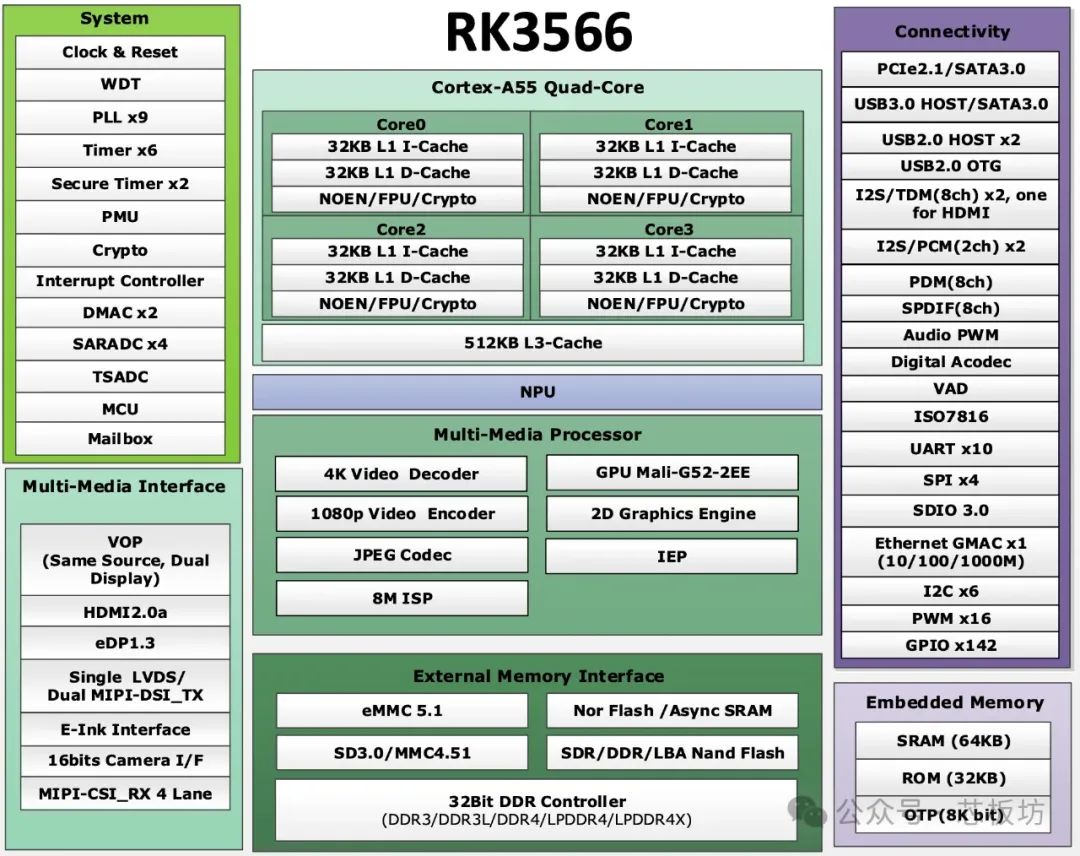Previously, I introduced the Radxa Zero 3W. If the Zero 3W aims to be a replacement for the Raspberry Pi Zero, the recent Radxa Rock 3C is designed to replace the Raspberry Pi 3B, offering better performance at a lower price.

It is equipped with an RK3566 SoC, featuring a quad-core Cortex-A55 running at 1.6GHz, and an ARM Mali G52-2EE GPU, providing 0.8TOPS computing power.

Currently, it offers options for 1GB, 2GB, and 4GB LPDDR4 memory, with an 8GB version also available.

It has an onboard Wi-Fi module, with options for different Wi-Fi modules, including the AP6256 module, supporting Wi-Fi 5 and Bluetooth 5.0.

There is also a newer version, currently unclear about the specific module model, supporting Wi-Fi 6 and Bluetooth 5.4.

It features three USB 2.0 OTG ports and one USB 3.0 Host port.
Gigabit Ethernet port, supports PoE power supply, requires an external PoE HAT.
HDMI interface, MIPI CSI camera interface, MIPI DSI display interface.
40Pin GPIO interface.
Fan interface.
Micro SD slot.
SPI Flash.
M.2 M-Key 2230 solid-state drive interface.
And an eMMC module interface, allowing for the installation of an eMMC module, which is a plus.

Dimensions match those of the Raspberry Pi 5.
Officially supports Ubuntu, Debian, Armbian, and Android. However, I have only seen the Debian 12 image so far.

The Radxa Rock 3C has a rich accessory ecosystem, compatible with Raspberry Pi ecosystem cameras and MIPI DSI displays. The official has also launched a four-bay SATA HAT, expanding the M.2 2230 slot to support 2242/2260/2280 solid-state drives.

25W PoE+ HAT.

Currently available on foreign sites like Arace.

2GB memory ¥184/$24.99
4GB memory ¥251/$34.99
8GB memory ¥331/$44.99
In China.

2GB 239
4GB 288.99
8GB 479
Not sure why there are such price differences, but it indicates that this development board has room for further price reduction.
Personally, I think this is a good development board, one that has few flaws given its chip.
The only issue is that the M.2 slot is a bit short. However, it has an eMMC slot, so it’s not too bad.

I also looked at the Orange Pi 3B, and the Radxa Rock 3C is almost identical to it.

Previously, the Orange Pi 3B 2GB was priced at 199, but I see it has been taken off the market. Not sure why.
I believe that the Rock 3C will be priced similarly to the Orange Pi 3B, or even cheaper, making it quite competitive.
In terms of aesthetics, I believe Radxa’s green color is more appealing.

In terms of ecosystem, I think they are comparable; both are similar, and I estimate the tutorials can be mutually referenced without affecting usage.
Therefore, for the Rock 3C to succeed, it needs to focus on cost-performance and find ways to improve or create differentiators, or even killer features, to truly succeed in the market.
Welcome to visit our development board selection website, though it is not yet fully developed, it has already listed around 500 development boards. If you are interested or have needs, feel free to check out our selection website. If you have any good suggestions, you can share them in the group or leave us a message.
Our website domain is: findboard.cn

(We have not yet adapted for mobile, so if you are visiting on a mobile device, the experience may not be very satisfactory. It is currently recommended to access via a computer browser.)